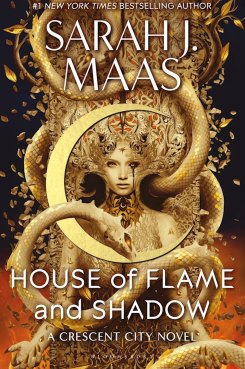
FANTASY
House of Flame and Shadow
Sarah J. Maas
Bloomsbury, $34.99
A couple of weeks ago, there was a rare moment of peace on BookTok, as Sarah Maas’ fans put down their phones to tackle House of Flame and Shadow, the third in her Crescent City series. Its publication was keenly anticipated overseas and in Australia, where more than 2 million copies of her 16 novels have been snapped up (worth about $38 million). It sits on top of the local fiction bestseller lists.

Fantasy author Sarah J. Maas’ latest novel has been snapped up around the world.Credit: Beowulf Sheehan
Coming off the brilliant commercial success of her last two series, A Court of Thorns and Roses and Throne of Glass, Crescent City is Maas’ breakaway from the young adult genre. The series follows a half-human half-Fae called Bryce Quinlan, who is trying very hard to take down a 15,000-year-old monarchy that oppresses humans.
The Fae are a species of preternatural creatures with extreme agility, heightened senses, and swift healing abilities. In each of Maas’ series, a group of Fae uses various magical powers to dismantle an oppressive ruling power.
Bryce is a 25-year-old art historian who comes from Midgard, a planet ruled by the Asteri, god-like beings who systematically harvest and feed off the magic of the various species living on the planet. They control the world with strict, species-based hierarchies that are embedded in powerful institutions, and through selective breeding and eugenics programs, and a comprehensive surveillance state. Technology in Midgard reflects our world: reality TV and social media are regular features, and all part of the way the population is controlled.

Credit:
Despite Crescent City having the oldest protagonist yet of a Maas book, Bryce doesn’t engage with the world as an adult. She treats ancient structures and powerful institutions with sarcasm and irreverence, surprisingly with no consequences. Each time she encounters a superpowered being meant to inspire fear (the reader is told they are brutal, impatient and have no regard for human life) she navigates the situation simply with the power of sass.
The stakes are lowered further and further, until she and the side characters are hardly even picking their feet up off the ground to get through the obstacles of the plot. Whether this is an attempt to endear the reader to Bryce, represent a character who is headstrong and relatable, or to show that she is immature and not prepared for leadership roles is unclear.
Maas loses the opportunity to create tension and the continuous lack of backlash towards Bryce puts the brakes on suspense.
The book raises several questions about the nurturing of a leader and the nature of following one, but answers only with a resentful, biased, and snarky protagonist who actively rejects attempts of diplomacy, yet is adored and wholly trusted by the characters following her. A line blurs as she becomes someone rejecting authority to gleefully lording it over others. As she accumulates more power, her role turns from revolutionary to queen.









 Add Category
Add Category